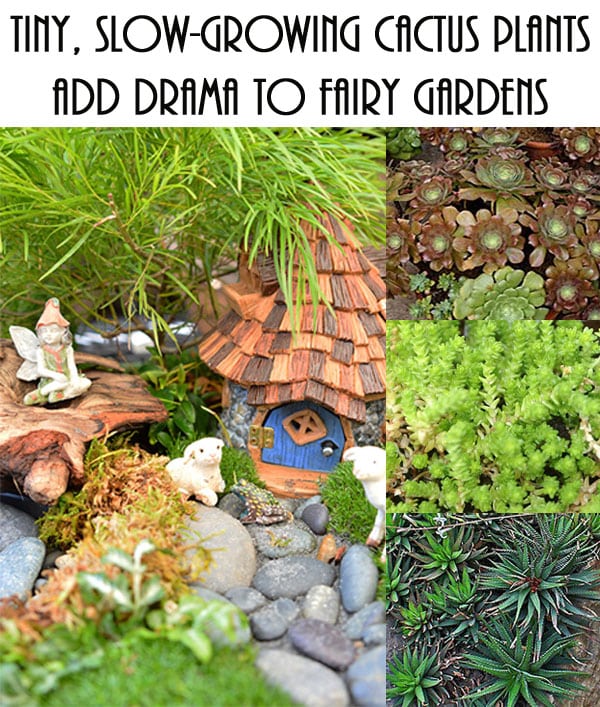Newsletter Articles
Tiny, Slow-Growing Cactus Plants Add Drama to Fairy Gardens
Written by Alicia R.
Magic is what many gardeners feel when taking a break from routine by visiting a garden center to enjoy the plant kingdom. Part of the enchantment involves taking a chance on plants you’ve never grown before. This may include many of the cacti and succulents available at Green Thumb Nurseries.
The broad array of shapes and colors among these species from desert and semi-arid lands may transport your imagination to realms of fantasy including fairy gardens. Similar to fairytales, fairy gardens don’t all tell placid stories with winged creatures resting on beds of moss.
Tiny, slow-growing cacti are made for themes involving prickly peril. Along with colorful, plump succulents, they add drama as well as beauty to fairy gardens.
Handling Spines Carefully
It may be hard to believe, but cactus spines are actually modified leaves. They are protective deadwood arising from microscopically small leaves. Their job is to help conserve water, deflect intense sunlight, and make cacti less palatable to wildlife. Also, although it may hurt if you get poked, cactus spines aren’t poisonous.
If you are growing cacti for the first-time but are worried about how to avoid pricks when planting a fairy garden, here are some tips:
•Use a pair of rubber-tipped tongs to manipulate tiny cacti into place.
•Wear leather gloves or a double pair of nitrile-dipped cloth gloves, which some cacti gardeners say are better at keeping fine needles from penetrating fingers.
•When touching cacti with gloved hands, do it gently. This not only minimizes pricking but also avoids damage to the plants.
•Plant the cacti first. Don’t try to squeeze them in between other plants in your display, because this is bound to cause more pain.
One especially cute, yet prickly example is Peruvian old lady (Espostoa melanostele). At first glance, it appears to be covered with a soft, white halo. But these touchable spines camouflage sharper needles underneath. This slow-growing choice would be fun for simulating clouds. Tuck them into the pockets of a strawberry planter next to a leafy Borage “beanstalk” for a figurine of Jack to climb up to the Giant’s castle.
Selecting Storybook Succulents
Succulents adaptable to fairy garden themes include creeping plants. One example is the Jade Necklace Vine (Crassula marnieriana) from South Africa, which grows slowly but eventually looks like a like a thick, plaited braid you might imagine flowing over the edge of a spill pot resting atop a rock garden (think “Rapunzel, Rapunzel, let down your hair!”).
Other fun creepers include European sedums — such as golden stonecrop (Sedum acre ‘Aureum’) — to form thickets around fairy garden castles. Sedums spread readily, so keep your fairy garden trimmed and transplant the cuttings to other parts of your landscape as groundcover.
Rosette-forming haworthias from South Africa look exotic enough to represent jungle foliage or underwater plants. Some such as Zebra plant (Haworthia attenuata and H. fasciata) look like agaves fit for a Southwestern fairytale.
Want to create a creepy Hansel and Gretel garden? Line a path to the witch’s candy house with European spiderweb hens and chicks (Sempervivums arachinoideum). Add colorful Sempervivum rosettes that look good enough to eat — something no one, including Hansel and Gretel, should do.
Not fond of fairytales but in love with the silly looking trees in Dr. Seuss books? Try aeoniums such as black rose (Aeonium arboreum ‘Zwartzkopf’). Blackish-burgundy rosettes atop gangly trunks are just right for a subtropical Seussian paradise.
Supporting these fantasies requires some know-how about desert-plant basics.
Understanding Basic Care
After planting cacti and succulents in their fairy garden scenarios, it’s best to let them settle in for about a week before watering. In the meantime, they will survive on moisture stored in their fleshy tissues. This storage capacity helps them both when water is short and during infrequent storms.
Cactus may shrivel at their base when in need of water, whereas succulent leaves wrinkle. When plump leaves easily fall off succulent stems, this indicates too much water as does mushiness or yellowing. Overwatering kills more cacti and succulents than underwatering. So, excellent drainage is necessary to avoid root rot. This means containers with drainage holes are the best choice for staging this kind of fairy garden.
As to soil, fill the planting areas with a 50/50 combination of rocky, mineral-rich desert potting mix and regular potting mix formulated for Southern California gardens. Also, desert plants aren’t heavy feeders, so keep fertilizer to a minimum, applying it sparingly and only during the growing season about once a month.
Finding Planters and Fairy Garden Supplies
In addition to miniature desert plants, you’ll find plenty of fairy garden figurines and structures at Green Thumb.
We also sell many containers appropriate for fairy gardens whether designed for inside or outdoor display. Shallow bowls work well for the small root balls of tiny succulents and cacti as do the spillers and strawberry towers already mentioned. Other good choices include moss baskets and hypertufa troughs made from Portland cement, peat moss and perlite. You’ll find tufa troughs at Green Thumb, but making your own can be fun. Here are instructions at Fine Gardening.
Whatever your project, Green Thumb has useful advice and supplies. Contact us today or visit one of our garden centers in Canoga Park, Lake Forest, San Marcos, Santa Clarita or Ventura for the help you need.
Do you like what you see? Sign up for our weekly newsletter to get content like this every week!
SOURCE
Spines
http://animals.sandiegozoo.org/plants/cactus
Plants (in order)
https://www.bhg.com/gardening/plant-dictionary/herb/borage/
https://myfolia.com/plants/5649-jade-necklace-vine-crassula-marnieriana
Sedum reflexum
https://www.ballseed.com/PlantInfo/?phid=056601239000735
https://mountaincrestgardens.com/haworthia-planifolia/
https://www.ourhouseplants.com/plants/haworthia

